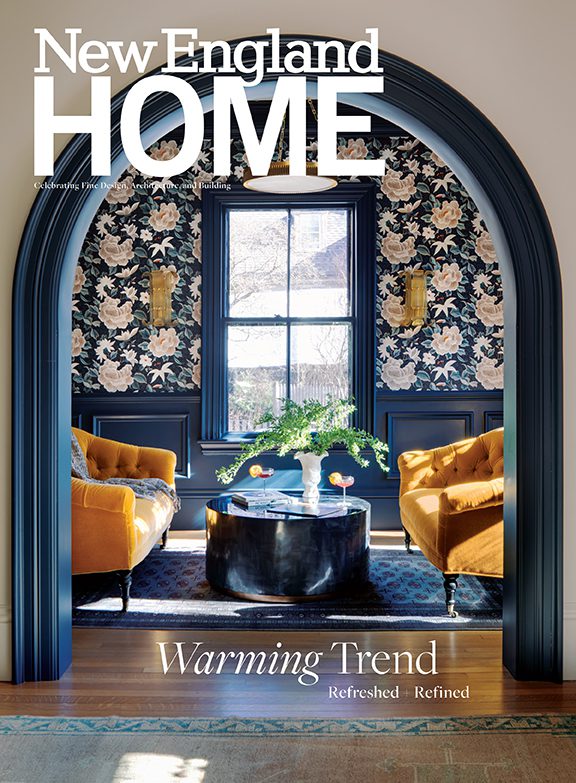Against the Grain
March 7, 2013
Furniture making may be an age-old craft, but artisans like New Hampshire’s Peter Sandback prove there’s always room for innovation and inspiration.
Text by Louis Postel
Furniture making may be an age-old craft, but artisans like New Hampshire’s Peter Sandback prove there’s always room for innovation and inspiration.
A converted garbage-truck garage in the far reaches of Harrisville, New Hampshire, may be not the first place one would look for design breakthroughs. But here, in what was once the garage’s oil-changing pit, something is going on that is making subtle, rather delightful changes in woodworking history. An improvised rig enlisting the services of a humidifier, a heater and a number of fans is morphing a cross-section of freshly cut oak into something quite new to the design universe: a perfectly stable end-cut veneer showing the concentric rings of the tree as it has grown over the years. Glued and pressed onto a substrate, this rare beauty is destined to serve as a top for one of Peter Sandback’s drum tables.
You might think of the basic vocabulary of woodworking and furniture making as fairly limited, even static—but you would be wrong. New techniques and technologies, changes in taste and artistic vision arise all the time. While many of the venerable techniques involved in fine furniture seem confined to predictable riffs on age-old themes—French polishing, marquetry, quarter sawing, distressing and so on—masters of the trade such as Sandback are creating pieces unlike anything that has come before. Sandback’s various creations range from hollow-core concrete tables to finished upholstery to lamps to unique tabletops like the oak veneer.
“Most people in the business would say you could never create an end-grain veneer like this cross-section table top,” Sandback says. “When you cut a tree like this oak, you get voids in the wood, pits filled with moisture that ultimately dry out and crack. But unlike other cross-sections on the market, this tabletop will not crack. The adhesive we use to fix it to the substrate has actually been pressed into its very cell structure.”
Sandback comes from a world where new and experimental are the operative words. More specifically, he grew up among the artist lofts of Soho in downtown New York before Soho became a fashion mall. His father, Fred Sandback, was a well-known minimalist sculptor, part of a circle that included Andy Warhol and Philip Glass. The elder Sandback worked primarily with string and yarn, leaning vast trapezoids against his studio walls while his young son caromed about on a three-wheeler. Now the youngster is a seasoned forty-six-year-old with a wife, three children and a successful business of his own. The fashion mecca Louis Boston and Boston architect David Hacin are part of a growing client base here in New England. Dennis Miller Associates represents Sandback in New York.
After studying sculpture at the Art Institute of Chicago, Sandback proceeded west to San Francisco’s Bay Area, where he founded his furniture business in 1992. (He and his family moved to New Hampshire in 1999.)
Early on, his lightweight, hollow concrete tables took off, though it is a line he tends to downplay in favor of newer work. “We spent the entire summer making eighty concrete-top tables for Oakland University outside Detroit,” Sandback says. “But back in ’08, just about all production had stopped. So I said the hell with it, I will do something decorative.” His frustration led ultimately to another breakthrough process.
For these new designs, Sandback prefers a very common, highly sustainable soft maple that he bakes or, in the parlance of his trade, “thermally modifies.”
Kiln-dried in the standard way, the wood then goes into a hotter kiln and gets heated to the point where it is just about to burst into flames. The process turns it a rich brown color. “None of these pieces are stained,” says Sandback. “The wood’s sugars have been thoroughly caramelized. When it’s used outside, it is impervious to mold without my having to resort to toxins such as copper sulfate.”
He then decorates the plank in a way that mirrors old-fashioned picotage on fabric. He takes a fabric, has it copied at an office store onto large sheets which he pastes temporarily to the surface. With a dentist-like instrument he drills hundreds of holes, into which he hammers nails. Once he cuts the shanks off with a grinding disc, he sands and finishes the surface. Constellations of silver nail stars flicker in the dark wood, their balletic swirls practically guaranteed to mesmerize anyone lucky enough to dine at one of his tables.
Like the end-grain-oak drum tables, the nail patterns in baked wood are very new, products of innovation and imagination. If the art of woodworking appears at risk of drying up and cracking over time, the Peter Sandbacks of the world are setting all such fears to rest. •
EDITOR’S NOTE: To see more of Peter Sandback’s work, go to petersandback.com.
Share
![NEH-Logo_Black[1] NEH-Logo_Black[1]](https://b2915716.smushcdn.com/2915716/wp-content/uploads/2022/08/NEH-Logo_Black1-300x162.jpg?lossy=1&strip=1&webp=1)













You must be logged in to post a comment.